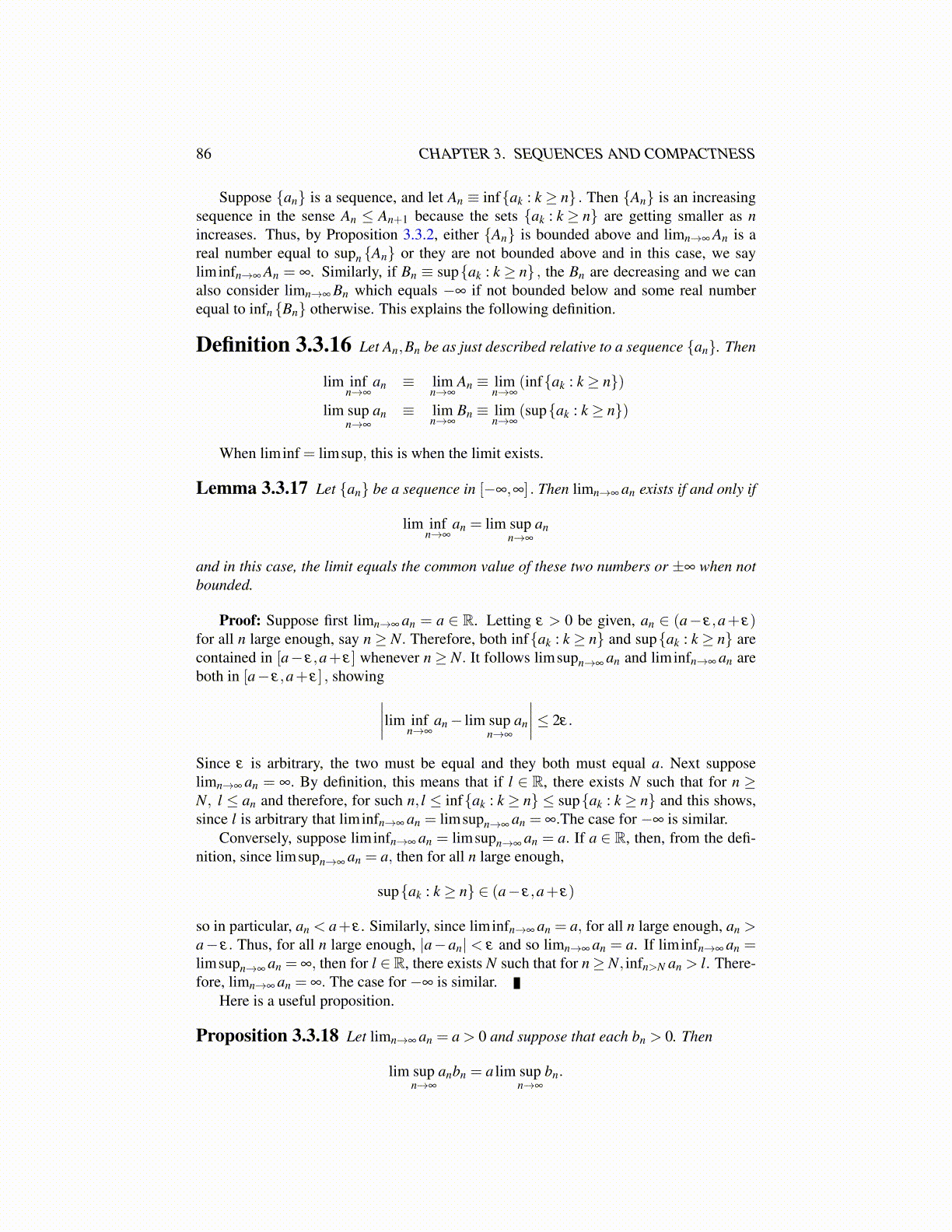
86 CHAPTER 3. SEQUENCES AND COMPACTNESS
Suppose {an} is a sequence, and let An ≡ inf{ak : k ≥ n} . Then {An} is an increasingsequence in the sense An ≤ An+1 because the sets {ak : k ≥ n} are getting smaller as nincreases. Thus, by Proposition 3.3.2, either {An} is bounded above and limn→∞ An is areal number equal to supn {An} or they are not bounded above and in this case, we sayliminfn→∞ An = ∞. Similarly, if Bn ≡ sup{ak : k ≥ n} , the Bn are decreasing and we canalso consider limn→∞ Bn which equals −∞ if not bounded below and some real numberequal to infn {Bn} otherwise. This explains the following definition.
Definition 3.3.16 Let An,Bn be as just described relative to a sequence {an}. Then
lim infn→∞
an ≡ limn→∞
An ≡ limn→∞
(inf{ak : k ≥ n})
lim supn→∞
an ≡ limn→∞
Bn ≡ limn→∞
(sup{ak : k ≥ n})
When liminf = limsup, this is when the limit exists.
Lemma 3.3.17 Let {an} be a sequence in [−∞,∞] . Then limn→∞ an exists if and only if
lim infn→∞
an = lim supn→∞
an
and in this case, the limit equals the common value of these two numbers or ±∞ when notbounded.
Proof: Suppose first limn→∞ an = a ∈ R. Letting ε > 0 be given, an ∈ (a− ε,a+ ε)for all n large enough, say n ≥ N. Therefore, both inf{ak : k ≥ n} and sup{ak : k ≥ n} arecontained in [a− ε,a+ ε] whenever n ≥ N. It follows limsupn→∞ an and liminfn→∞ an areboth in [a− ε,a+ ε] , showing∣∣∣∣lim inf
n→∞an − lim sup
n→∞
an
∣∣∣∣≤ 2ε.
Since ε is arbitrary, the two must be equal and they both must equal a. Next supposelimn→∞ an = ∞. By definition, this means that if l ∈ R, there exists N such that for n ≥N, l ≤ an and therefore, for such n, l ≤ inf{ak : k ≥ n} ≤ sup{ak : k ≥ n} and this shows,since l is arbitrary that liminfn→∞ an = limsupn→∞ an = ∞.The case for −∞ is similar.
Conversely, suppose liminfn→∞ an = limsupn→∞ an = a. If a ∈ R, then, from the defi-nition, since limsupn→∞ an = a, then for all n large enough,
sup{ak : k ≥ n} ∈ (a− ε,a+ ε)
so in particular, an < a+ ε . Similarly, since liminfn→∞ an = a, for all n large enough, an >a− ε. Thus, for all n large enough, |a−an| < ε and so limn→∞ an = a. If liminfn→∞ an =limsupn→∞ an = ∞, then for l ∈R, there exists N such that for n ≥ N, infn>N an > l. There-fore, limn→∞ an = ∞. The case for −∞ is similar.
Here is a useful proposition.
Proposition 3.3.18 Let limn→∞ an = a > 0 and suppose that each bn > 0. Then
lim supn→∞
anbn = a lim supn→∞
bn.